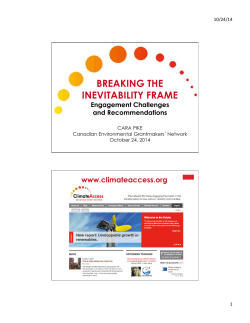
English
EXECUTIVE SUMMARY RENEWABLE ENERGY PROSPECTS: CHINA November 2014 Copyright © IRENA 2014 Unless otherwise indicated, the material in this publication may be used freely, shared or reprinted, so long as IRENA is acknowledged as the source. About IRENA The International Renewable Energy Agency (IRENA) is an intergovernmental organisation that supports countries in their transition to a sustainable energy future and serves as the principal platform for international cooperation, a centre of excellence, and a repository of policy, technology, resource and financial knowledge on renewable energy. IRENA promotes the widespread adoption and sustainable use of all forms of renewable energy, including bioenergy, geothermal, hydropower, ocean, solar and wind energy, in the pursuit of sustainable development, energy access, energy security and low-carbon economic growth and prosperity. IRENA is grateful for the generous support of the Chinese and German governments, which made the publication of this report a reality. The full country report for China, the REmap 2030 report, summary of findings and other supporting material are available at www.irena.org/remap For further information or to provide feedback, please contact the REmap team at remap@irena.org REmap reports are available for download from www.irena.org/publications Disclaimer While this publication promotes the adoption and use of renewable energy, the International Renewable Energy Agency does not endorse any particular project, product or service provider. The designations employed and the presentation of materials herein do not imply the expression of any opinion whatsoever on the part of the International Renewable Energy Agency concerning the legal status of any country, territory, city or area or of its authorities, or concerning the delimitation of its frontiers or boundaries. HIGHLIGHTS ●● China has become a global leader in renewable energy. It has vast resources and great potential for future development. In 2013, China installed more new renewable energy capacity than all of Europe and the rest of the Asia Pacific region. ●● The main drivers for this shift are the increasing cost-competitiveness of renewable energy technologies and other benefits such as improved energy security and decreased air pollution. ●● The share of renewables in China’s energy mix was 13% in 2010, including an estimated 6% traditional use of biomass, and 7% modern renewables. Hydro power (3.4%) and solar thermal (1.5%) accounted for most of China’s modern renewable energy use. ●● Under current policies and investment patterns, the share of modern renewables in China’s energy mix will rise to 16% by 2030. REmap 2030 estimates that it would be both technically and economically feasible to increase the share of modern renewables to 26%. ●● Reaching a 26% share for modern renewable energy would require investments of USD 145 billion per year between 2014 and 2030. Accounting for improved health and reduced carbon dioxide (CO2) emissions, renewables would bring savings of between USD 55 and USD 228 billion per year to China’s economy. ●● Under REmap 2030, the share of renewables in the power sector would increase from 20% to nearly 40% by 2030. This assumes accelerated growth in wind and solar PV, and full deployment of hydroelectricity. To achieve this requires significant growth in grid and transmission capacity, and power market reform. ●● Significant potential exists for renewable energy in end-use sectors. Industry can achieve a 10% renewable energy share, compared to almost none at present. The building sector can transform its fuel mix to two-thirds renewables. Solar thermal heat and electrification can help, as can modern biomass for process heating and space/water heating. E xe cut ive S umma r y 3 The case for renewable energy in China China’s energy policy matters globally. The country is the world’s largest energy user, accounting for one fifth of all global energy consumption. By 2030, China’s energy consumption is expected to increase by 60%. China’s energy choices will be a major influence on the world’s ability to curb climate change. There are rising concerns over energy security. As of 2014, about 30% of China’s natural gas supply is imported, but this could increase substantially. China imports more than half of its crude oil supply, and this will also increase. Shale gas was considered as an alternative, but local exploration proved challenging. Until recently, China has been meeting most of its energy demand with coal. However, growing concerns over the environmental impacts of coal (severe air pollution that caused 1.2 million premature deaths in 2010, high water consumption compounding water scarcity) have prompted a shift in policy. As a result, China is turning to renewable energy. It already has the world’s largest installed capacity of wind and hydroelectric power, as well as the vast majority of solar heating and biogas installations. In 2013 China installed more solar photovoltaic (PV) capacity than the whole of Europe. This strategy is bringing substantial economic returns. China has become a major exporter of renewable energy technology, accounting for two-thirds of global solar PV module production. Its renewable energy sector employed 2.6 million people in 2013. And it has the financial ability to invest further. 4 R e newa ble Energy P ros pe c t s : C hi na Under a business-as-usual scenario, China could fall far short of its full renewable energy potential. However, given the implementation of the right mix of policies, the country has the resources and the dynamism to lead a transformation of the global energy system. REmap 2030: China’s renewable potential REmap 2030 shows how the share of renewable energy in the global energy mix can be doubled by 2030. China’s role is crucial for it to succeed. Using projections from the Chinese Renewable Energy Centre (CNREC), IRENA calculates that the share of modern renewables (which excludes traditional uses of biomass) in China’s energy mix will rise from about 7% in 2010 to 16% by 2030 under the businessas-usual scenario (the Reference Case in this study). Under REmap 2030, however, with the right policies and support, the share of renewables in the energy mix could quadruple to 26% with technologies currently available. That would make China the world’s largest user of renewable energy, accounting for about 20% of global use. Hydroelectricity, wind power, solar PV, solar thermal and modern biomass would constitute most of the renewable energy mix of the country. A strategy for a diverse mix of renewables in the power sector China has massive potential to harness renewable energy for power. Currently, 20% of 2010 - 7.5 EJ REmap 2030 - 23 EJ CSP <1% Wind 2% Geothermal 2% Heat Biogas Industry* Buildings 4% Power sector Pow er se c Solar Thermal Heat 12% Biomass Heat/ District Heat Buildings 18% Wind 17% Power 29% Transport Fuels <1% Heat 70% End -u se Biofuels Transport <1% Biomass Heat Industry* 1% Biomass Heat/District Heat Buildings 7% Geothermal Power 0.1% Biomass Heat Industry* 7% Heat 47% Power 49% Hydroelectricity 21% Transport Fuels 4% End-use sec tor Biomass Power 1% Traditional uses of biomass 45% r to r cto se Hydroelectricity 26% Solar PV 6% Geothermal Heat 2% Solar Thermal Heat 20% Biomass Power 3% Biogas Power 1% Biofuels Transport 4% *incl. combined heat and power and district heat Modern renewable energy share could increase four times between 2010 and 2030. the country’s electricity comes from renewables. Under the business-as-usual scenario, this rises to 30% in 2030. With REmap 2030 options, it approaches 40%. Hydroelectricity would be the largest type, as is the case today, but wind and solar PV would see the largest growth and would play an essential role. Hydro: China’s hydroelectricity potential by 2030 is 400 gigawatts-electric (GWe). Already envisaged in the business-as-usual scenario, this will require significant crossboundary coordination, as well as enhanced river and water management. Total pumped hydro capacity, crucial for energy storage, should reach 100 GWe. Wind: Wind became China’s second largest source of renewable power in 2013 and has potential to grow further. The best wind resources are found in the northwest and north- east. REmap 2030 envisages a fivefold increase in onshore wind capacity, from 91 GWe in 2013 to 500 GWe by 2030 (twice the current installed capacity worldwide) and an additional 60 GWe capacity in offshore wind. For this to occur, the realisable resource potential by 2030 in northern China would need to be deployed, and the early retirement of some coal capacity would be necessary (mainly in western China). New grid and transmission capacity (including 100 new DC power lines) will be needed to link wind power with demand in southern and eastern China. Solar PV: China installed 13 GWe of solar PV capacity in 2013, a substantial increase which resulted in a total installed capacity of 20 GWe. 1 GWe came from distributed projects, such as rooftop solar PV on residential or commercial buildings. China aims to raise the total to 70 GWe by 2017, with equal contributions from utility-scale and distributed projects. REmap E xe cut ive S umma r y 5 2030 envisages a total installed capacity of 308 GW by 2030e which is twice the current installed capacity worldwide. Nearly 40% of this would be distributed. Challenges and solutions: —— —— 6 Costs and externalities: Wind and solar PV cannot compete with the low cost of coal power generation, based on today’s market prices. They do become cost-competitive, however, when accounting for coal’s significant externalities, such as air pollution and its impact on human health. China would need a nationwide price of about USD 50 per tonne of carbon dioxide (CO2) to raise the cost of coal power generation sufficiently to make distributed solar PV cost-competitive. Prices closer to USD 25-30 per tonne CO2 would ensure that wind and solar PV could compete with coal at utility scale. Grids and transmission: Power generation from both utility scale solar PV and wind in China has been curtailed by a lack of sufficient grid infrastructure, and because coal power plants are given priority dispatching. This is improving as preferential policies for renewables are introduced. Grid and transmission capacity issues will gain more importance in the future, as an important share of China’s wind and solar PV will need to be built far from population centres. Better regional coordination is needed to create power exchange and new interconnectors between provinces, and power trading with neighbouring countries (e.g., hydroelectricity from Siberia and Southeast Asia, or wind from Mongolia.) R e newa ble Energy P ros pe c t s : C hi na —— —— Distributed solar PV offers another solution. For this to be successful, business models need to be developed that result in higher rates of return, uncertainties in ownership should be resolved, and capacity growth needs to be accelerated. Power market design and infrastructure planning: The current electricity grid is not designed to handle high shares of variable renewable power. In order to accommodate this, accelerated power market reform will be needed, including establishing an electricity retail market segment, which would not only encourage competition on electricity retail prices, but also innovation in creating business models for applications of distributed generation renewable electricity. In parallel, China should expand the study on its future grid, particularly incorporating smart technologies to cope with large-scale variable renewables located in Northern and Western China, far away from the centers of the demand. The role of biomass in the renewable energy transition Under REmap 2030, modern biomass would account for a quarter of all China’s renewable energy use, primarily for end-uses such as fuel and heating. Reaching this potential poses significant challenges for data collection, substituting modern for traditional use of biomass, and transport logistics. Challenges and solutions: —— Biomass feedstock: China has abundant biomass resources, but utilising them sustainably and affordably will —— —— —— require carefully crafted policies. The main forms of biomass are straw (concentrated in the northeast and the lower Yangtze River) and fuel-wood (in the southeast and northeast). There is also potential from forestry residues. Transport of biomass feedstock from areas that are scattered across the country to specific centres of demand is a major challenge. Cooking/heating/power generation: Nearly all biomass today is used in traditional forms, i.e. for cooking. The share of the population that relies on traditional use of biomass is decreasing, and the use of modern cooking stoves is increasing. But the numbers are uncertain, and data collection needs to improve to assess the challenge ahead. Power production from biomass and waste could account for 10% of the total renewable power generation by 2030. Industry: Biomass in Chinese industry is currently limited to pulp and paper making, and only in small amounts. By 2030, biomass and waste could account for up to one-fifth of the process energy needed to produce clinker, one of the production processes that account for the largest share of energy use in China’s manufacturing industry. Biomass could also be used in industrial combined heat and power (CHP) plants and heaters to generate process heat (e.g., steam), but would still meet less than 5% of the industry sector’s total fuel demand. To utilize these potentials from limited use today requires significant efforts from the industry sector. Transport: The government is promoting the production of advanced biofuels from sustainable feedstocks. REmap 2030 envisages production rising from 2.5 billion to 37 billion litres. Already today around 200 million electric two and three-wheelers are on the road in China, by 2030 this could reach 500 million. The magnitude of growth in advanced biofuels production represents a challenge. Renewable energy options other than biomass: Realising the biomass potential in REmap 2030 would require at least twothirds of China’s total biomass supply potential to be utilized. Solar thermal for heating and different forms of electric transport are renewable energy technology options other than biomass. China is a global leader in solar thermal, and could increase its installed capacity six-fold under REmap 2030: 30% in manufacturing, and 70% in residential and commercial buildings. Electric vehicles already carry hundreds of millions of passengers every year, and could meet up to 20% of projected car demand by 2030, and as China’s power system becomes more renewable, so will the electricity these technologies consume. The cost of REmap 2030 The investment needed to achieve REmap 2030 would average USD 145 billion per year, between now and 2030. This is an increase of USD 54 billion per year in investments in renewable energy technologies over current projections. REmap quantifies costs from two perspectives: those of businesses, and those of governments. ●● From the business perspective, which includes end-user tax and subsidies, REmap Options could be deployed at an average incremental cost of E xe cut ive S umma r y 7 90 Primary Energy (EJ/year) 80 18% Reduction 70 60 42% Increase 50 40 48% Increase 30 7% Reduction 20 9% Reduction 10 No change 0 Coal Oil Natural Gas Nuclear RE low RE high In REmap 2030 coal use will be reduced to today’s levels and renewable energy could become the second largest source of energy ●● ●● USD 20.2 per megawatt-hour (MWh), or USD 5.6 per gigajoule (GJ). From the government perspective, which excludes energy tax and subsidies, the cost would rise to USD 24.8 per MWh (USD 6.9 per GJ). This translates to a bottom line additional cost of USD 58 billion per year for the entire energy system. When externalities are taken into account, such as human health and CO2 emission reductions, REmap 2030 results in net savings of USD 55-228 billion per year. Reducing CO2 emissions China is the world’s largest emitter of CO2, driven by its use of coal. Its power and enduse sectors produce around 7 Gt of CO2 per 8 R e newa ble Energy P ros pe c t s : C hi na year in 2012, and under business as usual scenario, this will grow by 50% by 2030. REmap 2030 shows that it is possible to limit this growth to 25% by substituting coal, mainly in the power sector. However, even with the potential of renewables estimated in this study, China’s coal use by 2030 will be very similar to its current levels. China will need to continue to deploy renewables beyond 2030, and improve energy efficiency in end-use sectors, in order to transition to a sustainable energy system. If REmap Options were achieved worldwide, coupled with higher energy efficiency, atmospheric CO2 concentration would stay below 450 parts per million (ppm) of CO2 helping to prevent average global temperatures from rising more than two degrees Celsius above pre-industrial levels. Policy needs REmap 2030 provides several recommendations to accelerate the transition to renewable energy. They include: Renewable energy policy: ●● Develop a comprehensive national energy plan that accounts for the needed infrastructure for transmission and distribution of electricity, heat and gas ●● Introduce taxation, caps, and/or CO2 trading systems to account for the damage of CO2 emission and other air pollution from coal combustion ●● Assess the socio-economic, energy security, health, land and water use impact of various technologies ●● Set targets for renewables in manufacturing, buildings and transport Power supply system and market design: ●● Establish the national power market, creating economic incentives for flexible operation, and bringing in new investors ●● Develop the grid to better integrate renewable energy, enhance trade and deal with variability ●● Improve knowledge and data collection on biomass and develop a working biomass feedstock market China’s energy use has grown rapidly in recent years, and by 2030 it will increase by another 60%. In a business as usual scenario, the country will not only be the world’s largest energy consumer by far, but also emit over twice the quantity of CO2 of the next largest emitter. Without increased deployment of renewable energy, China’s energy system will continue to result in high levels of air pollution, negatively affecting health, economic growth and the environment. Without the diversification of its energy system and a transition towards renewable energy, the country will become increasingly reliant on imported fossil fuels, affecting its national energy security and economic growth. China can choose a different path by accelerating the shift to renewable energy. There are challenges, including enhancing grid and transmission infrastructure, as well as biomass collection and logistics. These challenges can be overcome through effective planning and by creating mechanisms that value the external benefits of renewable energy. If China acts decisively to increase the role of renewables in its energy system, it can significantly reduce the pollution of its environment, enhance its energy security, benefit its economy and play a leading role in mitigating climate change. Technology focused policies: ●● Enhance government support for innovation, research and development to reduce renewable energy costs ●● Support development of next-generation renewable energy technologies E xe cut ive S umma r y 9 IR E N A H e a dq u a r te r s P. O. B ox 2 3 6 , Ab u D ha bi U n i te d A ra b E mi ra te s IR E N A I n n ova t io n an d Te ch n o lo g y C e n t re R o be r t- Schu m a n -P la t z 3 5 3 1 7 5 Bo n n G e rma ny www.ire n a.org www.irena.org Copyright©IRENA 2014
© Copyright 2025










